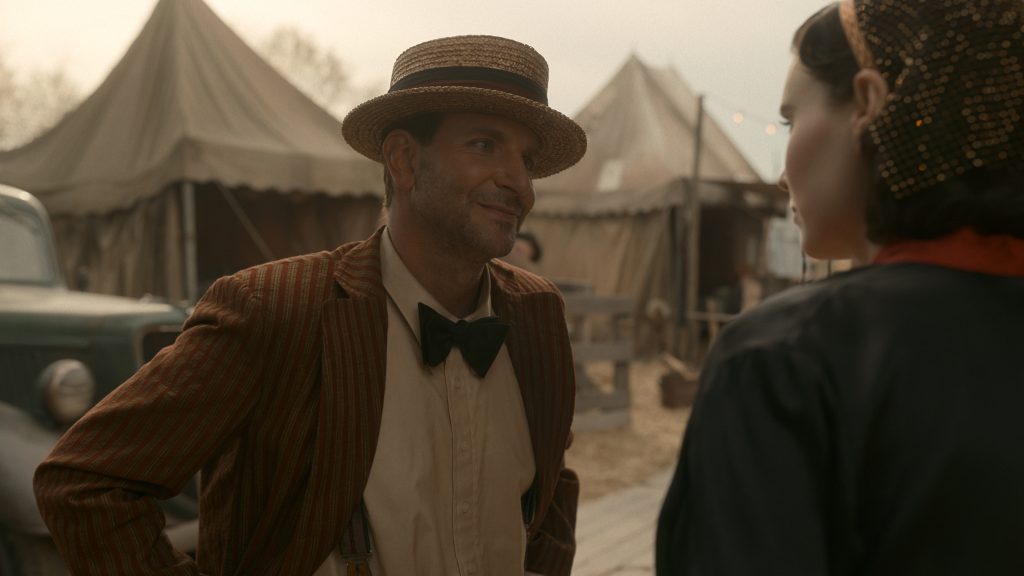Nightmare Alley Is Over Hyped
A disappointment for a fine director, but might still get some Oscar nods.

Bradley Cooper and Rooney Mara in the film NIGHTMARE ALLEY. Photo by Kerry Hayes. © 2021 20th Century Studios All Rights Reserved
Within the movie industry and even on cable networks there’s an Oscar publicity push for Mexican director Guillermo del Toro’s latest, Nightmare Alley. And given its acting lineup and movie lineage, no wonder.
Del Toro is the director of films I have admired such as Pan’s Labyrinth (a 2006 film combining fantasy and fascist horror) and The Shape of Water (elements of fantasy, romance and a creature from the black lagoon that cleaned up in 2018 at the Oscars).
Given his delight in the human underbelly and technical mastery of gloomy alley visuals, in a constant traveling camera and shocking intercuts of humanity’s darkest sides, del Toro had no hesitation in exploring a third-rate carnival and its denizens – in fact, adding to the macabre. The film tries yet lacks his usual collision of grim tale with historic resonance, but he has called in some notable acting names to roam this 1940s underworld:
Bradley Cooper as the central hustler, believing he can outguess everyone, Rooney Mara as his disquieted love interest, Toni Collette as his fortune-telling plaything, Ron Perlman as the menacing carny strongman, Willem Dafoe in a black wig and mustache as the ultimate nasty know-it-all, David Strathairn as the drunken pseudo-psychic who teaches him the ropes, Richard Jenkins as the savage rich guy he wants to fool, and Cate Blanchett as the cool psychiatrist who may outwit him. What a cast! And what a strangely slow and unconvincing movie as we wearily trudge through this masterfully-shot but endless tunnel of 1940s environments.
The film is interesting, though, in how language and meanings have changed. Today a “geek” can be an affectionate term for a computer nerd. In the 1940s a geek was the absolute dregs of show biz, a doped up drunk in the carny’s worst act, hired from town to town to bite the heads off chickens – an almost inhuman being who has driven himself to the bottom.
The suspense in the story has always been is seeing how the Cooper character gets there, from a drifter with a checkered past, but tons of good looks and immoral ideas to a smooth nightclub mentalist to an overly confident dapper-dressed trickster who undoes himself.
Del Toro is having a lot of fun foreshadowing and after-shadowing how the Cooper character has a lot of creepiness in his past and built-in weaknesses stemming from his self-confidence. But Cooper is unusually metronomic in how he handles character development, almost as if he is peeking at the next page of the script.
As the overly cool blonde manipulator, Blanchett is a strong but extreme version of herself – likely to be nominated on reputation because she is never bad. Of the others in the supporting cast, I thought only Dafoe and Jenkins showed anything special.
While I long to see del Toro’s future projects, including a grown-up version of Pinocchio, this cinematic circus is a mere sideshow and not worth the hullabaloo.
Dominique Paul Noth served for decades as film and drama critic, later senior editor for features at the Milwaukee Journal. You’ll find his blog here and here.
Movies
-
Republican Legislators Push Tax Credits for Films Made in Wisconsin
 May 21st, 2025 by Baylor Spears
May 21st, 2025 by Baylor Spears
-
Mystery Movie Being Filmed in Milwaukee With Kevin Spacey
 Apr 24th, 2025 by Jeramey Jannene
Apr 24th, 2025 by Jeramey Jannene
-
Two Documentaries Offer Lessons in Fame
 Apr 24th, 2025 by Dominique Paul Noth
Apr 24th, 2025 by Dominique Paul Noth




















I thought the 1947 film was great, although Eddie Muller admitted that it wasn’t a typical Film Noir. I’ll avoid seeing the new version based on this review. I really liked Pan’s Labyrinth, and you’ve talked me into checking out The Shape of Water, which I’ve passed on until now.